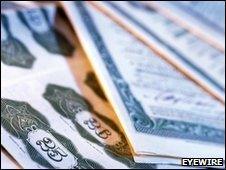How do bonds work?
- Published

Bonds are government debt
A bond is an IOU.
Those who buy such bonds are, put simply, loaning money to the issuer for a fixed period of time.
At the end of that period, the value of the bond is repaid. Investors also receive a pre-determined interest rate (the coupon) - usually paid annually.
For example, if a company or government issues a 10-year, £100m bond with a coupon of 5% it is saying, "In ten years time, I owe you £100m, and every year until then I will pay you £5m interest".
However bondholders can, if they wish, sell a bond to someone else before the agreed time period. And this is why bonds are interesting as the trade in them gives an indication of the level confidence in the company or government issuing the bond.
Here's how it works.
Bonds have a face value (usually what it is sold for initially), however they also have a market value which fluctuates.
A way of measuring the return investors are getting on a bond is known as the yield.
This is the rate of interest it pays, expressed as a percentage of its market value.
For example, if you bought a £100m bond with a 5% coupon, your yield would be 5%. (Coupon divided by value of bond x 100)
The yield of a bond is inversely related to its current price - meaning that if the price of a bond falls, its yield goes up.
For example, if our bond with a face value of £100m fell to a market price of £90m, the yield would rise to 5.55% (5/90 x 100).
If the price of our bond rose to £110m then the yield would fall to 4.54%. (5/110 x 100).
Even though the market price of a bond fluctuates, its face value (i.e. what it can be redeemed for at the end of the fixed period) remains the same - in this case £100m.
The higher the yield of a bond, the riskier it is seen to be and the greater the chance that a company or government which issued it may not be able to repay the money.
They may be more risky, however, but they do offer higher returns, making them attractive to some investors.
And when it comes to government bonds that are sold at auction, the level of demand for them when they are offered is seen as a sign of how confident investors are in a particular economy.
- Published3 May 2010